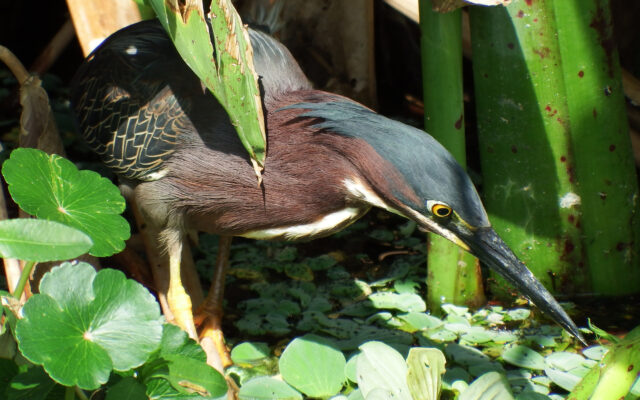
Songbirds are disappearing all over the place
By Bob Duchesne
Like most birders, I’m about to have a problem. Songbirds are going invisible.
There is a routine to birding in summer. Songbirds establish nesting territories in May and sing
through June. Most singing ends in July, but the chattering of call notes between parents and
fledglings persists.
By August, the families disperse. There is less incentive for birds to make noise. They melt into
their surroundings and disappear. As a bird guide, you’d have to be absolutely crazy to lead a
bird walk this time of year.
I’ll be leading a bird walk this time of year.
The hike on Aug. 30 is not just any bird walk though. It’s a late-summer morning ramble on Maine Audubon’s Borestone Mountain Sanctuary in Elliotsville. We’ll be navigating the trails around the mountain ponds, trying to find birds that don’t want to be found.
Worse, the walk begins at the Visitor Center, 1.3 miles uphill from the vehicle parking area at the
base of the mountain. Participants will have to hike to the hike. Sounds like a bird-guiding recipe
for failure.
Fortunately, I will have advantages, including a capable co-leader — my wife Sandi. We’ll be
traversing an especially bird-rich habitat of mature alpine forest, with a terrific mix of hardwood
and softwood trees.
Hawks may be migrating past the ridges. Waterfowl may visit the ponds. Best of all, it’s late enough in August that the songbirds may get noisy again.
By late August, birds are preparing to migrate. They’re flocking and fattening up. The flocks
flit through the trees, feeding as a pack, twittering noisily to keep the group together.
Mixed groups of warblers and other songbirds usually seek the company of chickadees when these foraging flocks form. Chickadees are routinely talkative. They are particularly quick to spot
danger and warn others. Even squirrels and other forest critters pay attention.
Foraging in large groups offers another advantage. Few insects can evade a warbler, once it’s been spotted. They usually try to avoid detection. But when a whole flock of birds
marauds through the leaves, bugs are more easily spooked into view.
Be alert. Foraging flocks appear randomly in late summer. Bring your binoculars into the woods
and listen for chickadees. They’ll tell you where the other birds are.
Alternatively, find an easier way to go birding in August. Visit a marsh. I recommend Essex Woods in Bangor. Ducks are off the nest and tending their youngsters out in the open, easy to see. Green herons and great blue herons forage openly.
Great and snowy egrets usually congregate. Even the secretive rails tend to step out of the reeds and onto mudflats. Early migrating shorebirds poke around the same mudflats, especially
solitary and least sandpipers.
Get on a boat. I recommend Bar Harbor Whale Watch. From late August through September, birds from all over the globe are in the Gulf of Maine. Many are up from the South Atlantic,
enjoying summer in the northern hemisphere while it’s winter below the equator.
Walk a mudflat. Shorebirds are most abundant in late August. I recommend South Lubec Sand
Flats, but there are many in Maine. All you need is mud.
Finding sufficient mud is not as easy as it sounds. Only part of the rockbound coast of Maine is
suitably muddy. The 20-foot tides in Washington County expose a vast area of mud.
But from Hancock through Waldo Counties, the 10-foot tides and rocky shoreline reveal less shorebird habitat. From Weskeag Marsh in Thomaston south to Scarborough Marsh near Portland, mudflats become extensive again.
Do nothing. Migration is already underway for some species. Most of those southbound departures are subtle and hard to notice, but some aren’t.
Swallows tend to fly early. When they do, they can swarm in big flocks. Common nighthawks do likewise. These migration events are not something you can look for. They’re just something you notice when they happen.
September is when most birds in Maine’s temperate zone are likely to head south, but birds nesting near the arctic feel the chill sooner. Some trickle into Maine in August, especially along the coast.
Caspian terns are the largest terns migrating through Maine. August is when we start seeing them. In about two weeks, the first red-necked grebes arrive in Maine’s saltwater bays, where they will spend the winter.
Spring migration is noisy. Birds announce their arrivals in song. Fall migration is quiet. Few birds
announce their departures.
Well, OK, Canada geese do, but that’s not until October.